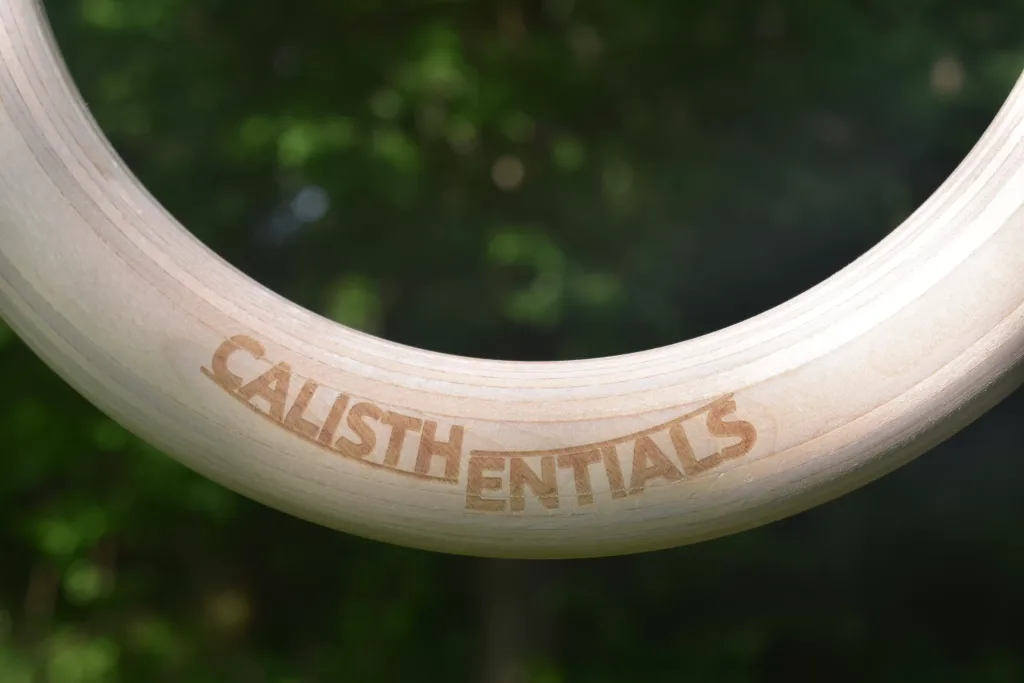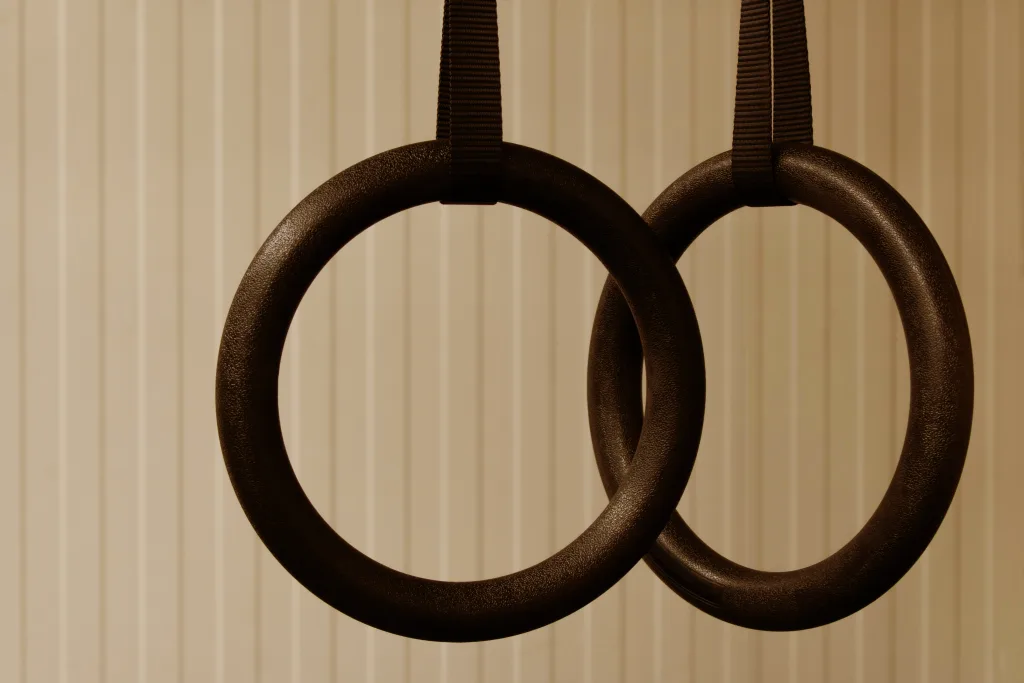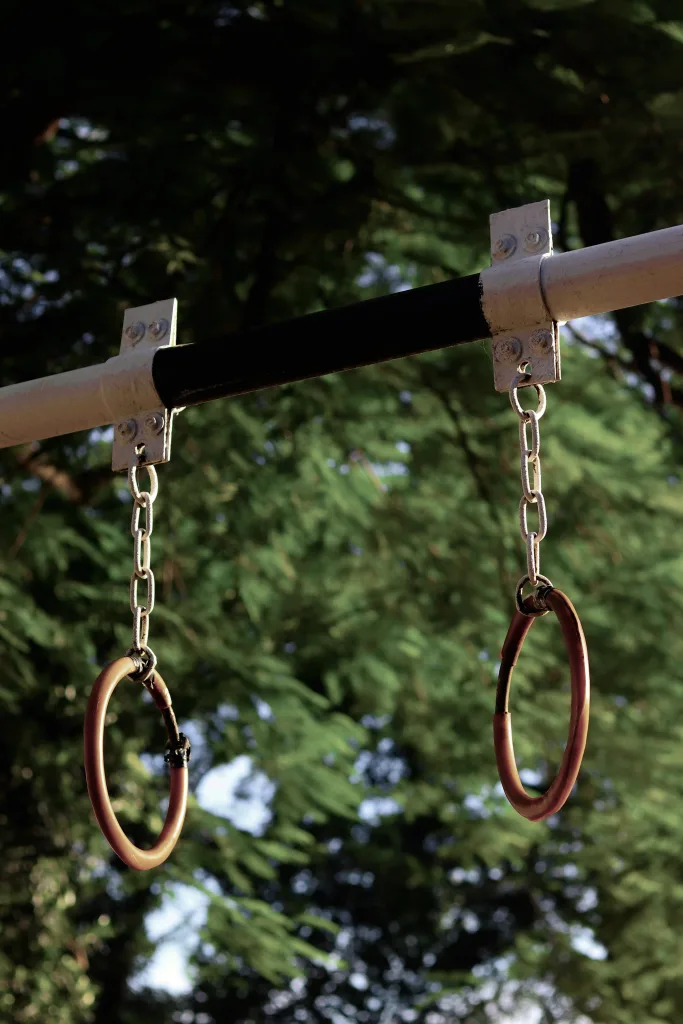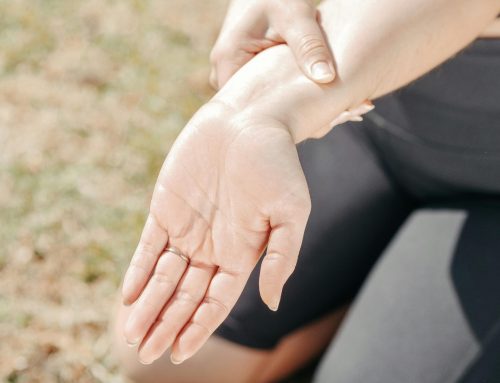Choosing the right set of gymnastics rings can change how workouts feel, how skills progress, and how long equipment lasts. This guide compares wooden vs plastic vs metal gymnastics rings so that athletes, beginners, and home-gym owners can make a smart choice based on grip, durability, and intended use.
Why Train With Gymnastics Rings
Gymnastics rings are one of the most versatile tools for building upper-body strength. They improve shoulder stability, and add instability that forces muscles to work harder to stabilize a position. This is especially true when above the rings. Using gymnastics rings challenges balance and requires muscular coordination that many fixed bars or machines simply don’t provide.
Rings are used in several different training styles from calisthenics and CrossFit to gymnastics and even general strength training. They are adjustable, allowing their difficulty to be changed to individual levels.
Beyond strength gains, ring training promotes joint-friendly movement patterns because the rings can rotate freely, letting the wrists, elbows, and shoulders find natural paths of motion. This can reduce impingement risk for some and encourages the development of stabilizer muscles that are often neglected with fixed equipment. Additionally, because each arm works independently, rings help expose and correct left-right imbalances and asymmetries that can impair performance or increase injury risk.
Practical benefits include extreme portability and low cost. Gymnastics rings can be hung from a pull-up bar, tree branch, or beam, enabling effective workouts almost anywhere. Programming with rings is highly scalable. Incorporating tempo variations, partial ranges, and isometric holds on rings can further accelerate progress and keep training varied and engaging.
Different materials also influence comfort and temperature sensitivity: metal rings can become uncomfortably cold or hot depending on the environment, which can affect grip and hand health during long sessions, whereas wood stays closer to ambient temperature and feels warmer and more natural. The surface finish matters too. A wooden ring will feel different than a textured plastic ring will. Ring diameter and thickness, which are often tied to material choices, play a role in hand fatigue and joint stress; thicker wooden rings can distribute pressure more evenly across the palm, while thinner metal rings may concentrate force and impact wrists and fingers differently.
Cost and portability are practical considerations linked to material as well. Plastic rings are typically the most affordable and lightweight for travel or outdoor use, while metal rings, especially those with higher load ratings, might be pricier but offer greater longevity for heavy users or commercial settings. For progression and programming, athletes and coaches often match material to goals. Beginners might benefit from the forgiving feel of wooden rings, whereas advanced athletes training high-intensity static holds or dynamic maneuvers may prefer the consistency and durability of metal or high-grade composite rings. Finally, strap compatibility and hardware quality should be checked regardless of ring material. Some materials pair better with specific buckles or swivels, and cheap straps can undermine the performance of otherwise suitable rings.
Benefits Of Wooden Gymnastics Rings

Wooden rings are prized for their superior grip and comfortable, natural feel. The texture of wood absorbs sweat slightly and provides a reliable hold for dynamic movements such as muscle-ups and false grips. This is why many gymnasts and calisthenics athletes prefer wooden options when performance and grip are priorities.
Another advantage of wooden rings is weight. They are generally lighter than metal rings, making them easier to move and adjust during workouts. The tactile feedback from wood also helps with proprioception, which can make skill learning smoother and more intuitive.
Cons Of Wooden Gymnastics Rings
Wooden rings are sensitive to the elements. Prolonged exposure to moisture, direct sunlight, or extreme temperatures can cause warping, cracking, or surface degradation. For that reason, wooden rings are best stored indoors or under cover when not in use.
Maintenance is another point to consider. Over time, wood can develop rough spots or splinters, so occasional sanding and care are recommended to keep the surface smooth. Those willing to maintain their gear gain an excellent grip and feel, but casual users might find the upkeep inconvenient.
Benefits Of Plastic Gymnastics Rings

Plastic rings are durable, weather-resistant, and typically more affordable than wooden or metal alternatives. That makes them attractive for outdoor setups and for people who need a hardy, low-cost option. They handle rain and sun better than untreated wood and don’t rust like metal.
Lightweight construction helps with portability and makes plastic rings a reasonable choice for travel or temporary setups. For new gym owners or schools that want an economical, long-lasting option for many users, plastic rings are often the go-to.
Cons Of Plastic Gymnastics Rings
The main downside of plastic rings is grip. Plastic tends to be smoother and can become slippery, especially when hands are sweaty. That can make advanced skills more difficult and potentially less safe without chalk or additional grip aids.
Plastic rings can also lack the premium feel that wooden rings provide. While comfortable for general training and more durable outdoors, they don’t offer the same tactile feedback that helps during technique-driven movements or precise holds.
Benefits Of Metal Gymnastics Rings

Metal gymnastics rings — typically made from steel or aluminum — are extremely durable and able to withstand intense, long-term use. Their structural strength makes them well-suited for permanent installations and heavy-load environments like commercial gyms or outdoor rigs.
Metal rings offer a solid, stable feel that some athletes prefer for brute-strength training. The rigidity and consistent shape help during heavy weighted work where deformation would be unacceptable.
Cons Of Metal Gymnastics Rings
Metal rings can be heavier and less forgiving on the hands than wooden or plastic rings. They are often cold to the touch and can feel slick, which impacts grip when hands are not chalked or when training in cooler conditions. For many, the tactile comfort is inferior to wood.
Rust is another concern. Without proper coating or maintenance, metal rings exposed to moisture can corrode over time. Even plated metals can scratch, exposing raw metal that may oxidize, so keeping them dry and maintained is important for longevity.
Indoor vs Outdoor Use
Deciding between wooden vs plastic vs metal gymnastics rings partly depends on where they will be used. Indoor environments favor wooden rings for their grip and feel; they perform best when protected from the elements and kept dry. For a home gym or indoor studio, wooden rings are often the preferred choice for long-term training.
Outdoor setups typically call for plastic or coated metal rings because they resist weather-related damage. Plastic rings stand up well to rain and sun and are usually the most budget-friendly outdoor option. Metal rings, when properly treated with weather-resistant coatings, can also work outdoors but require attention to rust prevention.
Which Material Is Best For Gymnastics Rings
There isn’t a single “best” material; the right choice depends on priorities like grip, durability, maintenance, and where the rings will be used. For athletes prioritizing grip and skill work, wooden rings are often the top pick. For low-cost, weatherproof gear, plastic rings make sense. For heavy-duty, permanent installations, metal rings are a strong option.
Practical recommendations: choose wooden rings for indoor calisthenics and gymnastics progressions, plastic rings for outdoor workouts in rainy weather and budget-conscious buyers, and metal rings for commercial or fixed outdoor rigs where durability under load is crucial. Consider adding chalk, straps, or protective covers to address grip or weather needs regardless of material choice.
Additional Buying Considerations
Beyond material, check the thickness of the ring, the quality of straps and buckles, and the overall build. Ring diameter and cross-section affect grip comfort — thinner rings may be easier to hold for some athletes, while thicker rings can be harder to wrap fingers around but may offer more durability.
Strap quality matters just as much as ring material. Look for strong webbing and reliable buckles rated for high loads. A weak strap can be the weakest link in an otherwise high-quality set of rings. Some kits include mounting hardware for permanent installs; others rely on separate anchors.
Maintenance Tips for Each Material
Wooden rings: keep them dry and store them indoors. Sand any rough spots lightly and apply light oil or finish if desired to protect the surface, but avoid heavy varnishes that can make the rings slippery.
Plastic rings: rinse off salt or grime if used outdoors and inspect regularly for cracks. Replace if stress lines appear. They generally need little maintenance but are prone to becoming slippery when wet.
Metal rings: dry after exposure to moisture and inspect for paint chips or rust. Apply rust inhibitor or touch-up paint as needed. Keep them coated and check the integrity of welds and fasteners in permanent setups.
Safety and Setup Notes
Proper installation is critical regardless of material. Ensure mounting points are rated for dynamic loads and that straps are threaded through buckles correctly. Check anchor points periodically and replace worn straps or rings showing significant damage.
Use appropriate protective gear — chalk helps with grip on plastic and metal, while wooden rings often need less chalk but still benefit from it during sweaty sessions. Gloves are generally not recommended for complex ring skills since they reduce tactile feedback.
Price and Value Considerations
Plastic rings typically cost the least, making them a low-barrier entry point. Wooden rings are mid-range in price but often offer better long-term performance for skill training. Metal rings can be the most expensive, particularly if they include heavy-duty mounting hardware and weatherproof coatings.
Value depends on intent. Spending a little more on wooden rings for dedicated indoor athletes can pay off in improved performance and comfort. For community or outdoor spaces, the durability of plastic or metal could make them more cost-effective over time.
However, in most cases, we recommend wooden gymnastics rings.
Final Thoughts
Selecting between wooden vs plastic vs metal gymnastics rings starts with honest answers about where and how the rings will be used. Grip, weather exposure, maintenance willingness, and budget all steer the decision. Each material provides a clear set of advantages and compromises.
Ready to Find the Right Rings for Your Training?
Overall we recommend getting a pair of wooden gymnastics rings.
Explore our curated selection of affordable, high-quality rings, straps, and accessories to take your training to the next level. Learn more about calisthenics training on our blog.




